Prambanan
group of temples in Indonesia
Prambanan is a complex of massive ancient Hindu temples (candi) in Central Java, Indonesia. It was built by the Mataram Kingdom, rulers of central Java and defeaters of the Sailendra Dynasty.
Understand
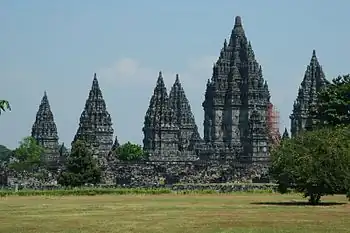
A UNESCO World Heritage Site, in almost any other country a magnificent ancient monument on the scale of Prambanan would quickly be designated a national symbol. In Indonesia, though, it is somewhat overshadowed by the even more awe-inspiring nature of nearby Borobudur. The two sites are quite different in style with Hindu Prambanan being a collection of sharp, jaggedly sculpted towers in contrast to the vast horizontal bulk of Buddhist Borobudur.
History
The first temple was built at the site around 850 CE by Rakai Pikatan and expanded extensively by King Lokapala and Balitung Maha Sambu the Sanjaya, king of the Mataram Kingdom. According to the Shivagrha inscription of 856 CE, the temple was built to honour Lord Shiva and its original name was Shiva-grha (the House of Shiva) or Shiva-laya (the Realm of Shiva). According to Shivagrha inscription, a public water project to change the course of a river near Shivagrha Temple was conducted during the construction of the temple. It is therefore slightly later but more or less contemporaneous with Borobudur. In the 10th century the temple was largely abandoned after the Mataram dynasty moved its court base to East Java.
|
The Legend of the Slender Virgin
After her father King Boko was defeated in battle, the Javanese princess Loro Jonggrang reluctantly agreed to marry his victor Prince Bandung, but only if he built a temple with 1,000 statues before sunrise. With the help of spirits, Bandung had completed 999, when the princess lit a fire to the east of the temple. Fooled into thinking it was dawn, roosters in the neighbouring village crowed and the spirits fled — and a furious Prince Bandung changed her into stone, the last and most beautiful of the statues. |
Most of the main temples collapsed during a major earthquake in the 16th century and the huge complex lay largely forgotten in the jungle. Following the Anglo-Dutch Java War, Java was briefly under British administration from 1811 to 1816. In 1811, a surveyor working for Thomas Stamford Raffles came upon the ruins of Prambanan by chance. The British and Raffles were not in power in Java long enough to really do much about Prambanan and looting became rife, with Dutch residents adorning their gardens with priceless statues and local people taking foundation stones and using them as construction material. Proper restoration began only in 1930 and still continues today.
Architecture
There used to be 240 temples in the complex but many of them have deteriorated or been looted leaving just scattered stones. There are three zones:
- The outer zone is a large open space that was once bounded by a large wall (long gone). The function of this space is disputed but was probably either a park or relaxation garden or the site of an ashram for temple priests Brahmins.
- The middle zone consists of four rows of 224 identical, concentrically arranged shrines. Most of these are in ruins but a few have been fully restored. These shrines are called Candi Perwara (guardian temples). The 224 Pervara temples are arranged in 4 concentric square rows; numbers of temples from inner row to outer row are: 44, 52, 60 and 68. There are several theories about the design and use of these shrines. Some believe that each of the four rows represent a level of the Mataram caste system and each was designed to be used by one caste only. Other theories include that these were designed to receive submissive offerings to the king or that they are simply beautifully designed places for meditation.
- The inner zone contains eight main temples and likewise, eight small shrines. This is certainly the holiest of the three zones and is a square elevated platform surrounded by a wall with gates corresponding to each of the four cardinal points. The three main inner shrines are dedicated to Brahma the Creator, Vishnu the Keeper and Shiva the Destroyer. The three main temples are called Trimurti temples. Right in front of these three main temples lies three Vahana temples, which are dedicated to the vehicles (vahana) of each god: Nandi, Garuda, and Hamsa. The two Apit temples located between the rows of Trimurti and Vahana temples on north and south side. The 4 Kelir temples are small shrines located on 4 cardinal directions right beyond the 4 main gates of inner zone, and four Patok temples, four small shrines located on four corners of inner zone.
Modern day Prambanan
Prambanan was designated at a UNESCO World Heritage Site in 1991 and its global profile as a tourist attraction rose markedly in the 1990s. The main Candi Loro Jonggrang is in a large, well-maintained park making this a pleasant and user-friendly place for visitors.
To understand a little of Prambanan and to get around all of the temples, you will need to set aside the best part of a full day. The complex opens at 06:00 so it is no bad thing to stay the night beforehand and get in before the crowds arrive from 09:00. This would also allow a leisurely return to Yogyakarta or Solo in the mid-afternoon taking in some of the other archaeological sites on the Prambanan plain. You will be required to wear a sarong as a sign of respect for the site. The sarong is only necessary for the main complex after which they will take the sarong back so go there first if you find the sarong warm to wear. This is a wet part of Java and a visit outside of the November to March period has the best chance of providing a clear, sunny day.
In the wake of the May 2006 Yogyakarta earthquake, some parts of Prambanan sustained significant damage. The big temple, Candi Siwa, was 60 percent damaged and subsequently renovated. Renovation of the Candis and the Prambanan site have been finished and were opened at the end of 2014 and all temples are open.
Tourism Information Office
- 🌍 PT Taman Wisata Candi Borobudur Prambanan Ratu Boko, Jalan Raya Yogya - Solo Km 16, ☏ +62 274 496401, prambanan@borobudurpark.co.id. The official government park authority for Prambanan.
Get in
The nearest major cities are Yogyakarta, 17 km to the south west and Solo about 40 km to the north east. The main road connecting these two large cities passes right by Prambanan and this makes transport links very straightforward. The nearest actual town to Prambanan is Klaten, about 3 km to the north.
By plane
Yogyakarta International Airport (YIA) is well served by domestic flights from Jakarta, Bali, other major domestic destinations and internationally from Singapore and Kuala Lumpur. An airport train is available to Yogyakarta which takes 43 minutes, where you can transfer to the KRL to Prambanan.
Yogyakarta Adisucipto Airport (JOG) is served by domestic propeller flights. It is 10 kilometres from here to Prambanan. The KRL train from Maguwo Station at Adisutjipto Airport to Prambanan costs Rp 8,000 and takes about 8 minutes. A taxi direct from the airport should cost about Rp 50,000 and take about 20 minutes.
Solo airport (SOC) is much smaller but has several flights each day from Jakarta and is also connected internationally from Singapore and Kuala Lumpur. Prambanan is about 90 minutes by bus from Solo airport.
By bus
TransJogja, Yogyakarta's bus service, serves a direct route to Prambanan. The bus is air-conditioned and comfortable, but sometimes can be overcrowded. Take number 1A from Malioboro street (Rp 3,600 one way). The first one leaves around 06:00, then every 10-20 minutes. The bus may transfer to number K3J at Adisutjipto Airport, typically when starting from southern bus stops like the one near Bank of Indonesia and Borobudur Damri shuttle bus stop. The 20-km journey normally takes around 30-45 minutes, but can take an hour when traffic is heavy. From the terminal station, cross the busy road, and turn right. Walk around 500 m to the pedestrian entrance, ignoring any non-signposted vehicle gates.
There are regular buses from Yogyakarta's Umbulharjo bus station (30 minutes), as well as a wide variety of tour agency-operated minibuses shuttling directly from Yogyakarta's backpacker haunts. Local buses to/from Solo are also easy to find (90 minutes).
By train
- 🌍 Brambanan Station. The station is a nine-minute walk from the temple complex. The KRL commuter train from Yogyakarta and Solo stops here. There are eleven trains from Solo and eleven trains from Yogyakarta every day. A journey from Yogyakarta takes about 30 minutes, and from Solo it takes about an hour. The station's name is not a misspelling; it has been that way since the Dutch colonial era. A one-way trip costs Rp 8,000. To ride the train, you can use a refillable multi-trip card that can be purchased at a ticket counter or vending machine at the station for Rp 30,000 (initial balance contains Rp 10,000). The multi-trip card is also valid for KRL commuter trains in Jakarta. Electronic money or bank-issued prepaid cards are a better alternative, as any credits are also usable for purchases at major retailers and convenience stores, the toll road, parking, and other public transportation (MRT and Transjakarta in Jakarta). Bank Mandiri's e-money or e-toll card, BCA's Flazz, BNI's tap-cash, BRI's BRIZZI, or Bank DKI's JakCard, are obtainable at the respective banks and minimarts such as Alfamart and Indomaret. (updated May 2020)
By taxi
A taxi from the center of Yogyakarta costs around Rp 60,000. The driver may be prepared to wait free of charge for an hour or so and then take you back for the same price, giving a total cost of Rp 120,000.
Get around
Prambanan can be fairly easily covered on foot. If the midday heat is too much, a toy train shuttles around the park for Rp 5,000.
If planning to do temples outside of the main area, having a vehicle may be preferable especially if doing more than one. Tours available.
See
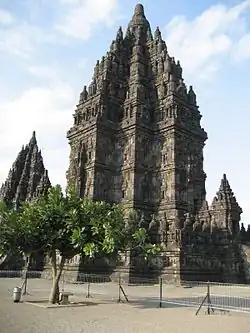
The main site of modern day Prambanan complex is inside a large, landscaped park. The complex is open daily from 06:30 to 17:00. Try to get there early to beat the heat. Entry costs Indonesians Rp 50,000 and Rp 25,000 for children under 10 years old, while foreigners adults are charged fixed US$45 or Rp 400,000 on Apr 2024. See details in table below.
| Type | Price |
|---|---|
| Adult | Rp 400,000 |
| Children (below 10 years old) | Rp 240,000 |
| Student (only with students card) | Rp 240,000 |
| Prambanan - Ratu Boko (Adult) | Rp 720,000 |
| Prambanan - Ratu Boko (Children - under 10 years old) | Rp 432,000 |
| Prambanan - Borobudur (Adult) | Rp 720,000 |
| Prambanan - Borobudur (Children - under 10 years old) | Rp 432,000 |
Guides can be hired at the ticket office for about Rp 150,000 per hour for 1-6 person(s), which is a good idea as it's a complex monument. Rp 200,000/hour for 7-20 persons.
- 🌍 Candi Prambanan (Candi Rara Jonggrang). 06:30 - 17:00. It is the largest and most-visited of the temples just to the left of the main entrance. While there were 237 temples built, most have long since crumbled and the main remaining attractions are the six temples of the central court, richly decorated with carved reliefs. Three of them, known as the Trimurti ("three sacred places"), are particularly important. About 2- 4-hr visit if doing all temples and museum. (updated Apr 2024)
- Candi Siva, dedicated to Shiva the Destroyer, is the largest of the six, rising to a height of 45 metres (148 ft). There are fine reliefs of the Ramayana in its forecourt and four chambers with statues. The largest chamber, to the east, contains a statue of Shiva, while the south has the sage Agastya, the west his son Ganesh (the elephant-headed) and the north his wife Durga. Durga is also known as Lara Jonggrang ("Slender Virgin"), a legendary beautiful princess turned to stone (see box).
- Candi Brahma, to the south, continues the story of the Ramayana and has a statue of Brahma the Creator inside.
- Candi Vishnu, to the north, tells the story of Vishnu's avatar Krishna and has a statue of Vishnu the Preserver inside.
- Opposite the three large temples are three smaller temples originally dedicated to the vehicles of the gods. Only the statue of Nandi, Shiva's bull, has survived.
- 🌍 Candi Lumbung. - translating to "rice barn temple", it is similar in appearance to nearby Candi Sewu but smaller in size. The temple is in a quite good condition, and made up of a main temple and 16 smaller ones.
- 🌍 Candi Bubrah. - this temple is believed to be part of the Sewu complex, and was found in ruins in the early 19th century and the name indeed translates to "ruin temple". It's no longer a ruin as the restoration was finished in 2017. Bubrah is the guardian temple of the southern direction and has one main stupa in the middle and several small ones on its roof.
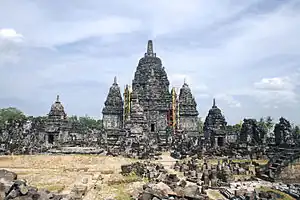
- 🌍 Candi Sewu. A large Buddhist temple complex meaning "one thousand temples", is one kilometre north of the entrance gate and contains a large central temple surrounded by a cluster of smaller ones. Despite its name, the complex only consists of 249 temples. The size of the renovated and intricately decorated central temple is impressive but the statue niches are all empty. Take note of the Borobudur style stupas. Entrance from the east side only.
- 🌍 Prambanan Museum. North of Candi Lara Jonggrang is a poorly displayed museum laid out in a series of small houses connected by walkways. Explanations are minimal, mostly only Indonesian text, but entry is free so you might as well take a look.
- Prambanan Audio Visual, inside the museum grounds, is the park's term for screenings of a film entitled "Sacred Prambanan". It makes for a fairly entertaining half-hour break with air-con. Indonesian with English subtitles. Rp 5,000 or free for foreigners.
Around Prambanan
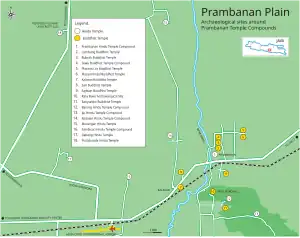
Other than temples within Prambanan archaeological park (Prambanan, Lumbung, Bubrah and Sewu temples) there are also other less visited and less touristy temples around Prambanan plain. If you interested in ancient Javanese temple architecture, the off the beaten path temples on hill tops or in the middle of the rice paddies through villages might interest you. After your visit to Prambanan, the Prambanan Archaeological park offers the group tour to these outlying temples, especially Ratu Boko. However if you prefer going on your own, rent and riding andong, a type of horse carriage (you must state the destination, for example Plaosan temple, and bargain for the price), or by taxi (if you took one from Yogyakarta earlier that has been waiting for you since there is no taxi around Prambanan area), or by daily rented car if you rent one earlier in Yogyakarta.
The entrance of these minor temples are guarded by archaeology bureau authorities. They will hand you a guest book and expect you to fill in your identity: name, origin and your opinion. It is for statistic purpose on visitors' data for each temple. There was no specific ticket rate to enter these temples (except of Ratu Boko), however the temple guard might expect donation, but that does not seem the case anymore in 2024.
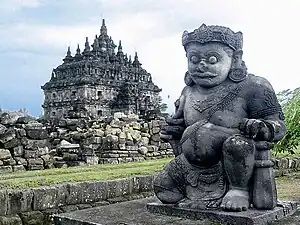
- 🌍 Candi Plaosan (About 30 min walk from Candi Prambanan main entrance and 45 min for Bus terminal Prambanan. Part not pedestrian friendly, passing through rice fields. No north east exit from main area (exists but closed) which would make a shorter walk to this temple.). 07:30 - 17:00. This Buddhist temple is about 2 km east of the northern edge of Prambanan park complex and is easily walkable from there. There are two large structures - Plaosan Lor (north) and Plaosan Kidul (south). This complex gives a good insight into the close relationship between Hinduism and Buddhism in 9th-century Java. Buddhist Plaosan was built during the same reign as Candi Loro Jonggrang. The Hindu king at the time had a Buddhist wife. There are some excellent intact reliefs and statues of Boddhisattvas here although most of the statuary was looted long ago. 30- to 60-min visit. Foreigner Rp 50,000, domestic adult Rp 10,000, children Rp 2,000. (updated Apr 2024)
- 🌍 Candi Sojiwan. A Buddhist temple with architecture similar to Mendut temple near Borobudur. The temple was restored in 2012. The main chamber is empty and the temple is notable for its Jataka fable Buddhist tales carved on panels around its foot. In a village 1.5 km south of Prambanan between Prambanan and Ratu Boko.
- 🌍 Kraton Ratu Boko (take the minor road from Prambanan towards Piyungan and this palace is on your left after about 3 km). South of Prambanan. The ruins of a large palace or temple, located on a hill 200 metres above the Prambanan plain. The origin is uncertain, but is popularly described as the palace of King Boko from the Prambanan legend. The hilltop has a viewpoint of Prambanan that is popular at sunset, and makes for good pictures using a zoom lens. A series of pools suggests palace bathing quarters. Only building foundations remain and it's difficult to make sense of the sprawling site, and the available guides may not speak English. Ratu Boko is incorporated into the Borobudur Park Authority, but entry is separately charged >10 years old: US$25, aged 3 to 10 US$15. There is a combined ticket with Prambanan that saves a few dollars.
- 🌍 Banyunibo (ask for the information and direction in Ratu Boko park authority. Take the village road southeast from Ratu Boko around 1.5 km.). A 9th-century Buddhist temple
- 🌍 Candi Barong. Located east of Ratu Boko on the neighboring hilltop, close to Banyunibo. It is a Hindu temple on the stone platform on the hill overlooking the valley. (updated May 2020)
- 🌍 Candi Ijo. 4 km southeast from Ratu Boko. The Hindu temple houses a large Linggam and Yoni symbol of Shiva. The temple consists of one main temple with three lesser templed. Because it is on the hilltop of another hill and quite remote, it is advisable to reach these temples by taxi (from Yogyakarta) or rented car.
- 🌍 Candi Kalasan. This Buddhist temple is the oldest temple in Prambanan plain 3 km west of Prambanan. Take the main road from Prambanan heading back towards Yogyakarta, after 3 km the temple can be seen easily on south (left) side of the road. It is the oldest temple in Prambanan plain. According to Kalasan inscription, it was built to honour Tara, a female boddhisattva. The temple throne is now empty, statue of Tara probably made from bronze and have been looted for scrap metals for centuries, however the carvings of boddhisttvas are interesting.
- 🌍 Candi Sari. This Buddhist temple was the vihara (temple and lodging) for Buddhist monks. Several hundreds meters north from the Kalasan temple in a walking distance. Just cross the main road to north side, walk east heading to Prambanan direction, after several hundred metres turn left into small village road and heading north until the temple is visible. The carving of Taras and Boddhisattvas are exquisite. Examine the winged human celestial creature similar to angels on the northern wall. The temple was originally coated by white plaster called 'vajralepa'. The temple was two storeys, with an upper deck made from wooden structure, the remnant of place to hold wooden beams can be seen.
- 🌍 Candi Sambisari. This Hindu temple pre-dates Prambanan by about 30 years, was only discovered in 1966, and is remarkably complete. Some archaeologists speculate that it is part of a yet to be discovered, much larger complex which lies hidden under centuries of volcanic ash and earth on the Prambanan Plain. Take the main road from Prambanan heading back towards Yogyakarta. When you reach the village of Sambisari, turn north (right) and follow the small road to the end.
- 🌍 Candi Gebang. A small Hindu temple discovered in 1937 near the Yogyakarta northern ring-road. The temple displays the statue of Ganesha and interesting carvings of faces on the roof section.
- 🌍 Candi Gana. Rich in statues, bas-reliefs and sculpted stones. Frequent representations of children or dwarfs with raised hands. In the middle of housing complex. Under restoration since 1997.
- 🌍 Candi Kedulan. Discovered in 1994 by sand diggers, 4 metres (13 ft) deep. Square base of main temple visible. Secondary temples not yet fully excavated.

Do
- 🌍 Ramayana Ballet Prambanan. An open-air theatre inside the park, just west of Candi Prambanan right across the Opak river, has ballet Javanese dance performances of the great Hindu epic Ramayana on four nights during each full moon between May and October (dry season). The performance involves around 200 artists; dancers and gamelan musicians for about 2 hours, and is performed on Tuesday, Thursday and Saturday nights. This performance, set against the starry sky and the lit backdrop of Prambanan with new LED lighting, is quite spell-binding. Enquire at travel agents locally or at your hotel for tickets and times. During the rainy season (November to April) the performance is held in the smaller indoor Trimurti theatre. The ticket price in 2015 wass between Rp 100,000 to Rp 350,000. (updated Mar 2021)
- Prambanan Jazz Festival. The annual jazz music festival that is usually held around July, where local and international musicians play. (updated Nov 2020)
- Jeep temples tours (Kiosks near Candi Prambanan entrance). Prambanan Classic Jeep: Rp 250,000 to 750,000 (2 to 5 stops), Jeep Wisata Shiva Prambanan: Rp 350,000 to 650,000 for short to long trips (3 to 8 stops). (updated Apr 2024)
Buy
Hawkers hassle tourists near the entry gate but will generally take the hint after a terima kasih (thank you) or two.
There is a large 🌍 market just outside the gate selling lots of touristy souvenirs. Those shops can be found on your way out from the complex and usually will take you 5-10 minutes to navigate.
Eat
There are many good value Indonesian warungs in and around Prambanan. A good tip is to follow the local Indonesian tourists - they always know which has the best food.
- 🌍 Taman Prambanan Restoran (Pendopo Taman Prambanan), Jl. Candi Sewu, Bener, Bugisan (close to the entrance gate). Serves typical Javanese dishes at very competitive prices. (updated Mar 2021)
- 🌍 Restoran Prambanan (Prambanan restaurant), Candi Prambanan, Tlogo (just east from the museum). Offers rice with various side dishes from Rp10,000. (updated Mar 2021)
- 🌍 Ramayana Resto (Prambanan Garden Resto), Jl. Raya Solo (on the west side of the temple next to the Prambanan open-air stage). Serving Indonesian food buffet with Rp75,000 per pax. Usually visited in late afternoon to nightfall for a stop over dinner while waiting for Prambanan Ramayana Ballet performance next door at 19:30. The restaurant is set against the majestic flood-lit Prambanan temple as the background which make a romantic setting for dinner while waiting for the Javanese dance performance. (updated Mar 2021)
Drink
Drink hawkers are omnipresent. The museum also has a drinks stand and there are benches scattered throughout the park for a quick break.
After a walk around Prambanan in the heat, a glass of fresh local juice or a pitcher of iced Javanese tea goes down very well.
Sleep
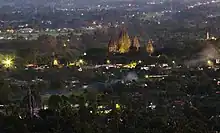
There are a few hotels here if you want to spend the night (not such a bad idea if you want to see Prambanan before the crowds arrive and before the heat of the day sets in). However, most visitors take a day trip from Yogyakarta or Solo.
- 🌍 Candi View Hotel, Jalan Candi Sewu, Prambanan, ☏ +62 274 7151222. Simple budget hotel on the main entrance road towards the rear of the complex. Rp 160,000.
- 🌍 Hotel Galuh, Jl Manisrenggo, ☏ +62 274 496855, office@hotelgaluhprambanan.com. Mid-market hotel which is popular with local tour groups. North east of the main complex. Has a swimming pool and two tennis courts. Rp 330,000.
- 🌍 Abhayagiri Sumberwatu Heritage Resort, Dusun Sumberwatu, Sambirejo, ☏ +62 274 4469 277, +62 274 4469 266, +62 274 446 9255. A resort on a hill with views of Mount Merapi and Prambanan Temple. Rpm1,134,000. (updated Mar 2021)
Connect
The telephone area code for Prambanan is the same as Solo - 0271
- Ambulance: 118.
- Police: 110.
The nearest police station to Prambanan is 3 km away at Klaten although officials at Prambanan more or less take the role of policemen.
Go next
- Borobudur, the largest Buddhist monument in the world, is an hour away by car.
Travelling other than by car: public transport is available to take you east or west from here
- East
- West